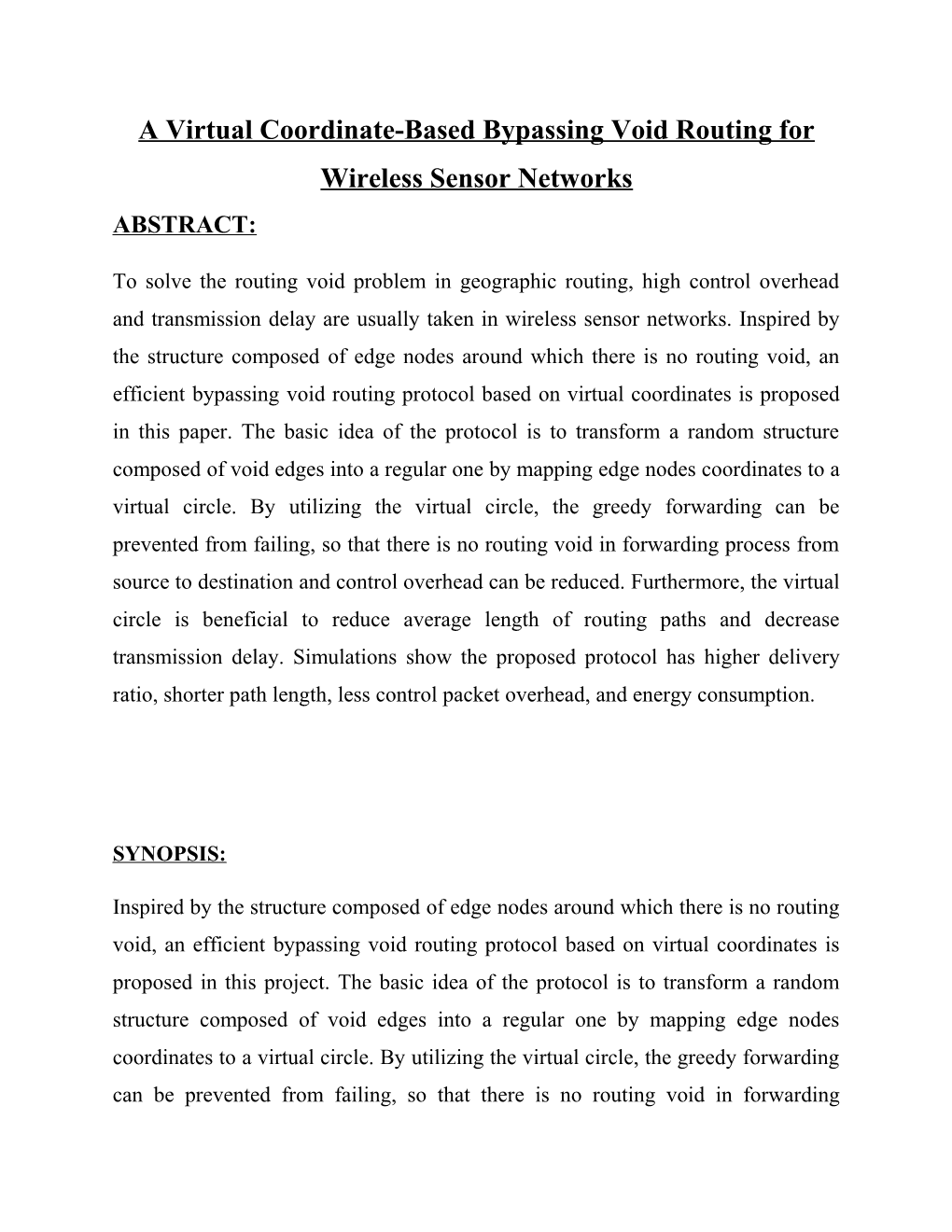A Virtual Coordinate-Based Bypassing VoidRouting for Wireless Sensor Networks
ABSTRACT:
To solve the routing void problem in geographicrouting, high control overhead and transmission delay are usuallytaken in wireless sensor networks. Inspired by the structurecomposed of edge nodes around which there is no routing void,an efficient bypassing void routing protocol based on virtualcoordinates is proposed in this paper. The basic idea of theprotocol is to transform a random structure composed of voidedges into a regular one by mapping edge nodes coordinates to avirtual circle. By utilizing the virtual circle, the greedy forwardingcan be prevented from failing, so that there is no routing voidin forwarding process from source to destination and controloverhead can be reduced. Furthermore, the virtual circle isbeneficial to reduce average length of routing paths and decreasetransmission delay. Simulations show the proposed protocol hashigher delivery ratio, shorter path length, less control packetoverhead, and energy consumption.
SYNOPSIS:
Inspired by the structure composed of edge nodes around which there is no routing void, an efficient bypassing void routing protocol based on virtual coordinates is proposed in this project. The basic idea of the protocol is to transform a random structure composed of void edges into a regular one by mapping edge nodes coordinates to a virtual circle. By utilizing the virtual circle, the greedy forwarding can be prevented from failing, so that there is no routing void in forwarding process from source to destination and control overhead can be reduced. Furthermore, the virtual circle is beneficial to reduce average length of routing paths and decrease transmission delay.
EXISTING SYSTEM:
Ring-constraint forwarding (RCF) establishes a multi-ring region around a routing void, in which relay nodes are selected to avoid routing void and balance energy consumption. In active route guiding protocols, relay nodes are selected according to the geographic location relationship between the destination node and the routing void in order to prevent failing of greedy algorithm.
These algorithms above have low complexity, but high overhead of control packet and time delay result in high energy consumption and inefficient transmission. Beyond that, routing void problem still exists around those established regions, and that no further scheme is proposed to solve this problem.
When void is encountered, face forwarding mode begins to work among the virtual nodes. However, paths established by face forwarding are not optimized; a longer path may be chosen even if there exists a short one.
DISADVANTAGES OF EXISTING SYSTEM:
- High overhead
- Inefficient transmission
- Increased time delay
PROPOSED SYSTEM:
An efficient bypassing void routing protocol based on virtual coordinate mapping (BVR-VCM) is proposed in this project. The basic idea of BVR-VCM is to build virtual coordinates of the whole void edge nodes by mapping their geographic coordinates to a virtual circle that covers the void, and then establish a path by using these virtual coordinates. The virtual circle composed of edge nodes can solve routing void problem and make greedy algorithm work in entire forwarding process, in this way overhead of control packets are reduced. Furthermore, the establishing and maintaining for virtual coordinates are not affected by alternation of destination node, thus energy consumption can be reduced.
ADVANTAGES OF PROPOSED SYSTEM:
- Reduced control packets
- Energy consumption can be reduced
- Higher delivery rate
SYSTEM ARCHITECTURE:
BLOCK DIAGRAM:
SYSTEM REQUIREMENTS:
HARDWARE REQUIREMENTS:
System: Pentium IV 2.4 GHz.
Hard Disk : 40 GB.
Floppy Drive: 1.44 Mb.
Monitor: 15 VGA Colour.
Mouse: Logitech.
Ram: 512 Mb.
SOFTWARE REQUIREMENTS:
Operating system : Windows XP/7/LINUX.
Implementation: NS2
NS2 Version:NS2.2.28
Front End: OTCL (Object Oriented Tool Command Language)
Tool:Cygwin (To simulate in Windows OS)
REFERENCE:
Dejing Zhang and Enqing Dong, “A Virtual Coordinate-Based Bypassing VoidRouting for Wireless Sensor Networks”, IEEE SENSORS JOURNAL, VOL. 15, NO. 7, JULY 2015.
